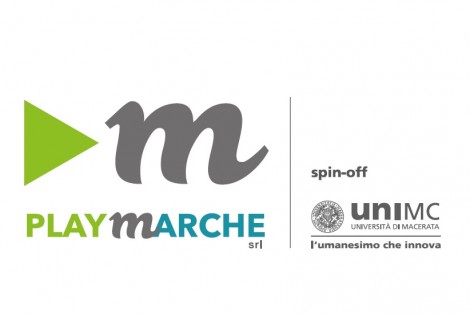Tra il materiale archeologico che venne recuperato nel letto del fiume Potenza, oltre al coronamento di un altare, vi erano anche tre documenti epigrafici, tutti riconducibili ad un contesto funerario.
Lastra con misure di area sepolcrale
Frammento di lastra che ricorda le misure in piedi romani di un’area funeraria privata, forse legata ad una famiglia. Alla luce del testo conservato, apprendiamo che l’area sepolcrale, il cui proprietario non è noto, misurava m 14,70 x 7,40. Il testo è il seguente:
In fron(te) p(edes) XLVIII,
in agr(o) p(edes) XXV.
Nella fronte 48 piedi, nei fianchi 25 piedi.
In via di ipotesi, si pensa che la lastra in questione e alcuni dei blocchi recuperati nell’alveo del Potenza nel 1967, fossero pertinenti ad un sepolcro con recinto, la cui struttura architettonica rimane ad oggi sconosciuta.
L’iscrizione si data su base paleografica alla prima metà del I secolo d.C.
Boll. Arte, 28, 1984, p. 46 (G. Paci); EDR079762.
Ara di Quinto Petrusidio Vero
L’epigrafe ci restituisce l’epitafio di Quinto Petrusidio Vero, deceduto poco prima di compiere il secondo anno di vita. Dal testo apprendiamo che il monumento venne fatto realizzare dal padre, Quinto Petrusidio Aristone, di condizione libertina, e dal fratello, suo omonimo, i quali per l’occasione allestirono un complesso funerario destinato ad accogliere i membri della famiglia dei Petrusidii, tra cui anche Petrusidia Ifide, già defunta al momento della realizzazione del sepolcro, forse la madre del bambino. Si segnala che l’epigrafe attesta la presenza a Ricina di un collegium dedito al culto del Genius municipi, la divinità tutelare dei Ricinenses. L’adprecatio (supplica) agli dèi Mani, con cui si apre l’epigrafe, la menzione dell’organizzazione municipale di Ricina e la paleografia consentono di circoscrivere l’iscrizione al I secolo d.C.
Dis
Manibus.
Q(uinto) Petrusidio
Q(uinti) f(ilio) Vel(ina tribu) Vero.
5 Vixit annum I,
mensib(us) XI, dieb(us) XXI.
Q(uintus) Petrusidius Q(uinti) l(ibertus)
Aristo, pater,
col(legiatus) V̅I̅vir(um) Aug(ustalium),
10 patronus collegi
Geni municipi, et
Q(uintus) Petrusidius Aristo,
fatrer, et sibi et
Petrusidiae Iphidi
15 posterisque suis et
eorum.
H(oc) m(onumentum) h(eredem) n(on) s(equetur).
Agli dei Mani. A Quinto Petrusidio Vero, figlio di Quinto, iscritto alla tribù Velina, che visse un anno, undici mesi e ventuno giorni. (Lo posero) il padre Quinto Petrusidio Aristone, liberto di Quinto, membro del collegio dei seviri augustali e patrono del collegio del Genius del municipio e il fratello Quinto Petrusidio Aristone, per lui e per Petrusidia Ifide e per i loro discendenti. Questo monumento non passerà all’erede.
Boll. Arte, 28, 1984, pp. 39-43 (G. Paci); EDR079760.
Stele di Erennia Cervilla
Stele in marmo proconnesio di forma rettangolare e cuspidata superiormente. L’epigrafe restituisce l’epitafio di una donna, Erennia Cervilla, la quale tratteggia la propria vicenda in prima persona, secondo un procedimento tipico dei carmina epigraphica, cioè dei testi epigrafici in versi. Nelle parole che la defunta pronuncia si riconoscono quattro settenari trocaici, metro caratteristico della poesia popolare.
L’unico elemento che permette di datare l’iscrizione è la paleografia, che suggerisce di inquadrare l’epigrafe al III secolo d.C.
D(is) M(anibus).
Herennia L(uci) f(ilia) Cervilla
uxor, vixi annis XVIII et
diem tricesimum.
5 Liberis tribus relictis,
vita(m) finivi dolens.
Co(n)iux karus ut memoriae
posuit hoc vivos mihi,
ut prodesset in suppre-
10 mis talem titulum
consequi. C(aius) Carrenas
Verecundus coniugi
incomparabili b(ene) m(erenti).
Agli dei Mani. Io Erennia Cervilla, figlia di Lucio, sono vissuta come moglie per diciotto anni e trenta giorni. Lasciati tre figli, ho concluso la mia vita nel dolore. L’ amato coniuge quando era vivo lo pose per la mia memoria, affinché mi fosse da conforto nel momento estremo ricevere da lui questa iscrizione. Gaio Carrenate Verecondo alla moglie incomparabile e meritevole.
Boll. Arte, 28, 1984, pp. 43-46 (G. Paci); EDR079761.
Coronamento di altare
Porzione superiore di altare. Il coronamento, che poggia su due gole dritte e listelli, presenta i pulvini, la trasposizione dei cuscini cilindrici in stoffa che ornavano gli altari durante i riti. È probabile che nel blocco centrale vi fosse un’iscrizione.
Il pezzo è genericamente riconducibile all’età imperiale.
L’iscrizione funeraria di Athamans, Tarquitiorum servus
La pietra, che si presenta molto rovinata, riporta il testo di un’iscrizione funeraria. Vista per la prima volta apud theatrum “presso il teatro” nel 1967, non si ha alcuna notizia circa le circostanze di rinvenimento. È molto probabile che l’epigrafe provenga dalla vicina necropoli, la stessa a cui originariamente appartenevano le altre iscrizioni di natura funeraria qui esposte. Il tipo di lavorazione della pietra, un calcare grigio, e l’assenza di grappe e incassi permette di ipotizzare che l’iscrizione facesse parte di una struttura monumentale a dado.
Il testo dell’iscrizione è il seguente:
[A]thamans,
Tarquiti(orum) Q(uinti), A(uli), L(uci) s(ervus),
pa[.]Io[---]s.
Atamante, servo di Quinto, Aulo, Lucio Tarquitii, (?)
L’iscrizione, mutila a sinistra, si apre con il nome di uno schiavo, di origine grecanica, Athamas, che si presenta ‘alla latina’. Segue il gentilizio dei tre domini (padroni), i cui praenomina sono rispettivamente Quintus, Aulus e Lucius, appartenenti ai Tarquitii, gens di origine etrusca.
A seguito di controlli effettuati sulla pietra sono state individuate le tracce di una terza riga, nello specifico una P, una A, la parte finale di un’asta, la curvatura di una lettera rotonda e una S. Alla luce delle lettere rilevate, è stata proposta l’integrazione pa[n]to[mimu]s, a indicare il mestiere svolto dal defunto.
L’epigrafe, per la tipologia monumentale e per le caratteristiche del testo, fra le quali si ricorda ad esempio l’assenza dell’adprecatio (supplica) agli dèi Mani (presente nelle iscrizioni funerarie di Quinto Petrusidio Vero e di Erennia Cervilla) e per la paleografia si data al I secolo a.C., non oltre la prima età augustea.
CIL I² 3299; EDR156307.
The epigraphs
In February 1966, among the materials discovered and collected along the course of the Potenza river, besides the crowding element of an altar, there were also three epigraphs referring to a funerary context.
Slab with measurements of a burial area
Fragment of slab which reminds of measurements in roman feet of a private burial area, probably linked to a family. According to the preserved document, the burial area, whose owner is unknown, measured 14.70x7.40 m. The text goes as follows:
In fron(te) p(edes) XLVIII
in agr(o) p(edes) XXV
on front 48 feet, on sides 25 feet
It is thought that the slab and other blocks recovered along the course of the Potenza river in 1967, belonged to an enclosed sepulcher, whose architectural structure is today unknown.
The inscription is dated - on paleography – to the first half of the I century A.D.
Altar of Quintus Petrusidio Vero
The epigraph contains the epitaph of Quintus Petrusidio Vero, died shortly before his second year of age. We know from the text that the monument was commissioned by his father, Quintus Petrusidium Aristone, freedman, and by his homonymous brother: they decided to set up a funerary complex for all the members of the Petrusidii family. Among them, there was also Petrusidia Ifide, already dead when the funerary monument was being built, and who was maybe the mother of the dead child. The epigraph testifies for the presence of a collegium in Ricina devoted to the worship of the Genius municipi, that is the tutelary deity of the Ricinienses. The adprecatio (supplication) to the Mani deities, in the opening of the epigraph, the inclusion of the municipal organization and the paleography allow to date the inscription to the first century A.D.
Dis
Manibus.
Q(uinto) Petrusidio,
Q(uinti) f(ilio), Vel(ina tribu), Vero.
5 Vixit annum I,
mensib(us) XI, dieb(us) XXI.
Q(uintus) Petrusidius, Q(uinti) l(ibertus),
Aristo pater,
col(legiatus) V̅I̅vir(um) Aug(ustalium),
10 patronus collegi
Geni municipi, et
Q(uintus) Petrusidius Aristo
fatrer et sibi et
Petrusidiae Iphidi
15 posterisque suis et
eorum.
H(oc) m(onumentum) h(eredem) n(on) s(equetur).
To the Mani deities. To Quintus Petrusidium Vero, son of Quintus, registered to the Velina tribe, who lived one year, eleven months and twenty-one days. (Laid by) the father Quintus Petrusidio Aristone, freedman of Quintus, member of the collegium of the Sodales Augusales and patron of the collegium of the Genius of the municipality and the brother Quintus Petrusidio Aristone, for him and for Petrusidia Ifide and their descendants. This monument will not be passed to the heir.
Stele of Erennia Cervilla
Stele of proconnesian marble with overall rectangular shape and cuspate shape on top. The epigraph contains the epitaph of a woman, Erennia Cervilla, who talks about her story in first person, following the typical rules of the carmina epigraphica, or epigraphic texts in verses. The words she says are organized in four trochaic septenarii, typical of popular poetry.
Paleography is the only element which allows to date the inscription to the third century A.D.
D(is) M(anibus).
Herennia L(uci) f(ilia) Cervilla
uxor, vixi annis XVIII et
diem tricesimum.
5 Liberis tribus relictis,
vita(m) finivi dolens.
Co(n)iux karus ut memoriae
posuit hoc vivos mihi,
ut prodesset in suppre-
10 mis talem titulum
consequi. C(aius) Carrenas
Verecundus coniugi
incomparabili b(ene) m(erenti).
To the Mani deities. To Erennia Cervilla, daughter of Lucio, I lived as a wife for eighteen years and thirty days; left three children, I ended my life in sorrow. The beloved spouse when he was alive placed it for my memory so that it would comfort me at the last moment to receive from him this inscription. Gaio Carrenate Verecondo, to his incomparable and worthy wife.
Coping of altar
Upper portion of altar. The coping stands on two straight throats and strips and presents pulvini, the transposition of the cylindrical cushions in cloth that adorned the altars during the rites. Probably on the central block there was an inscription.
Funerary inscription of Athamans, Tarquitiorum Servus
The stone, which is seriously damaged, includes the text of a funerary inscription. First seen apud theatrum ‘at the theatre’ in 1967, no news is available concerning the circumstances of its discovery. The specific type of stonework, which is grey limestone, together with the absence of brackets and recesses allows the hypothesis that the inscription may have belonged to a cubic monumental structure.
The text of the inscription goes as follows:
[A]thamans,
Tarquiti(orum) Q(uinti), A(uli), L(uci) s(ervus),
pa[.]Io[---]s.
Atamante, slave of Quinto, Aulo, Lucio Tarquitii, (?)
The inscription, mutilated on the left, opens with the name of a slave of Greek origins, Athamas, here in its Latin form. The nomen gentilicium of the three domini (masters) follows, whose praenomina are respectively Quintus, Aulus and Lucius: all of them belong to the Tarquitii, gens of Etruscan origin.
After inspections on the stone, traces of a third line have been identified, specifically a P, an A, the final part of a line, a letter’s curving, and an S. Following these discoveries, the integration pa[n]to[mimu]s has been proposed, since it refers to the job of the deceased.
The epigraph, due to its monumental type, the features of the text – for instance, the absence of the adprecation (supplication) to the Mani deities (included in the funerary inscriptions of Quintus Petrusidio Vero and of Erennia Cervilla, here displayed) – and the paleography, is dated to the first century B.C., not after the first Augustan era.






